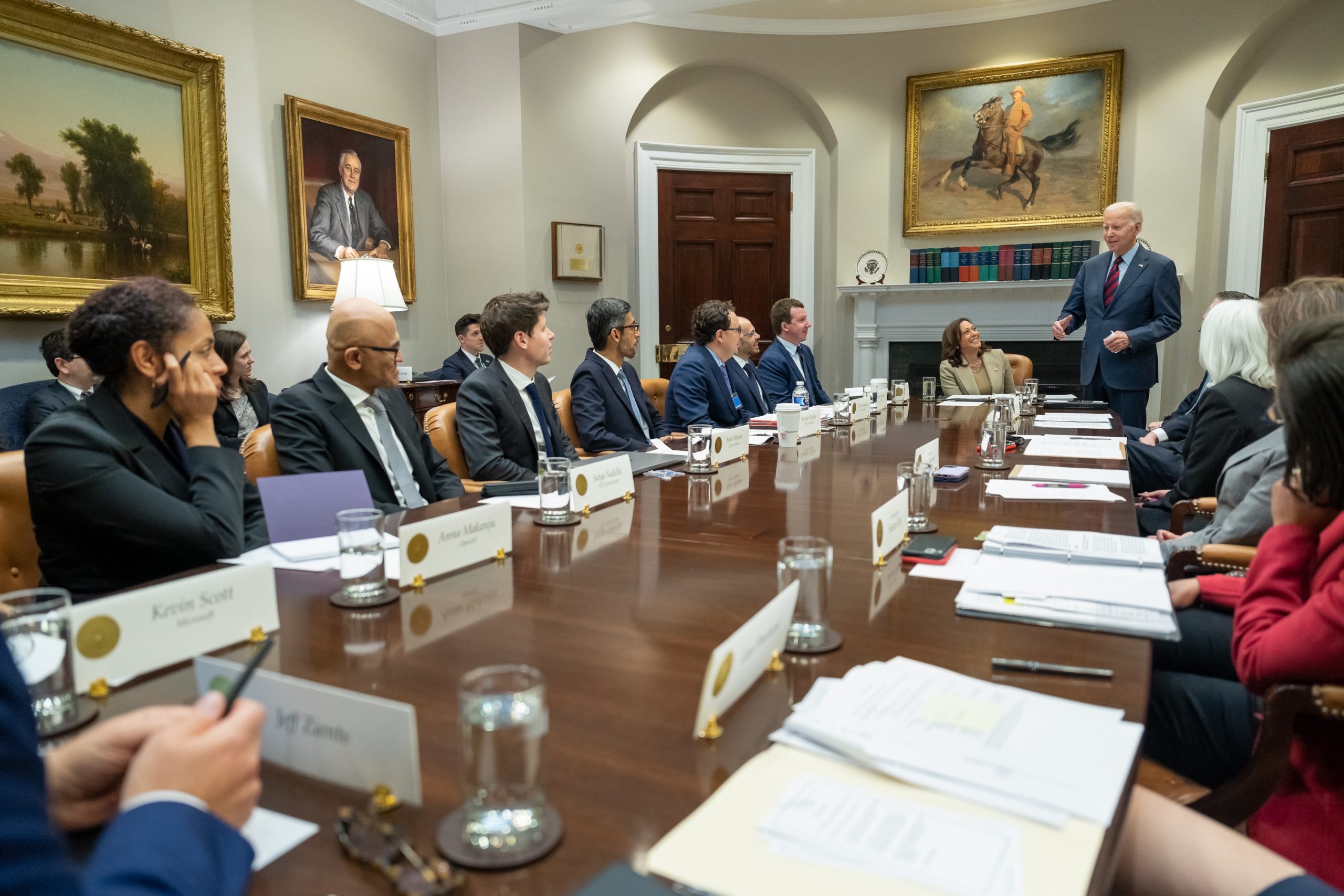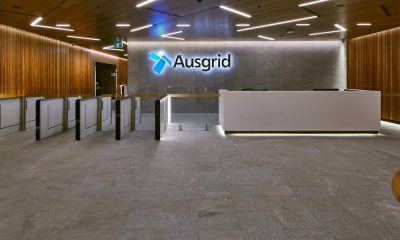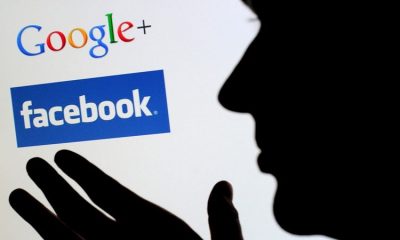News
White House meets Microsoft, Google CEOs on AI dangers

The White House is hosting CEOs of top artificial intelligence companies, including Alphabet Inc’s Google and Microsoft, on Thursday to discuss risks and safeguards as the technology catches the attention of governments and lawmakers globally. Generative artificial intelligence has become a buzzword this year, with apps such as ChatGPT capturing the public’s fancy, sparking a rush among companies to launch similar products they believe will change the nature of work.
Today, @POTUS and @VP met with CEOs to underscore the fundamental responsibility companies have to ensure their AI products are safe before they’re released, and the importance of responsible American innovation in AI that protect people’s rights and safety. pic.twitter.com/r6k9s3pGDU
— The White House (@WhiteHouse) May 5, 2023
Millions of users have begun testing such tools, which supporters say can make medical diagnoses, write screenplays, create legal briefs and debug software, leading to growing concern about how the technology could lead to privacy violations, skew employment decisions, and power scams and misinformation campaigns. President Joe Biden has also used ChatGPT, a White House official told Reuters. “He’s been extensively briefed on ChatGPT and (has) experimented with it,” said the official, who asked that they not be named.
Thursday’s two-hour meeting which began at 11:45 am ET (1545 GMT), will include Google’s Sundar Pichai, Microsoft Corp’s Satya Nadella, OpenAI’s Sam Altman and Anthropic’s Dario Amodei, along with Vice President Kamala Harris and administration officials including Biden’s Chief of Staff Jeff Zients, National Security Adviser Jake Sullivan, Director of the National Economic Council Lael Brainard and Secretary of Commerce Gina Raimondo. “We aim to have a frank discussion about the risks we see in current and near-term AI development,” said a senior administration official, speaking on condition of anonymity. “Our North Star here is this idea that if we’re going to seize these benefits, we have to start by managing the risks.”
Ahead of the meeting, OpenAI’s Altman told reporters the White House wants to “get it right.” “It’s good to try to get ahead of this,” he said when asked if the White House was moving quickly enough on AI regulation. “It’s definitely going to be a challenge, but it’s one I’m sure we can handle.”
The administration also announced a $140 million investment from the National Science Foundation to launch seven new AI research institutes and said the White House’s Office of Management and Budget would release policy guidance on the use of AI by the federal government. Leading AI developers, including Anthropic, Google, Hugging Face, NVIDIA Corp, OpenAI, and Stability AI, will participate in a public evaluation of their AI systems.
Shortly after Biden announced his reelection bid, the Republican National Committee produced a video featuring a dystopian future during a second Biden term, which was built entirely with AI imagery. Such political ads are expected to become more common as AI technology proliferates.
United States regulators have fallen short of the tough approach European governments have taken on tech regulation and in crafting strong rules on deepfakes and misinformation. “We don’t see this as a race,” the senior official said, adding that the administration is working closely with the U.S.-EU Trade & Technology Council on the issue.
In February, Biden signed an executive order directing federal agencies to eliminate bias in their AI use. The Biden administration has also released an AI Bill of Rights and a risk management framework. Last week, the Federal Trade Commission and the Department of Justice’s Civil Rights Division also said they would use their legal authorities to fight AI-related harm. Tech giants have vowed many times to combat propaganda around elections, fake news about the COVID-19 vaccines, pornography and child exploitation, and hateful messaging targeting ethnic groups.
But they have been unsuccessful, research and news events show. Just about one in five fake news articles in English on six major social media platforms were tagged as misleading or removed, a recent study by activist NGO Avaaz found.
Source: Reuters
News
Mobile tariff hike:Congress blames NDA government for Rs 34,824 crore burden on public

NEW DELHI: Hitting out at the NDA-led Narendra Modi government over three private firms increasing mobile service tariffs, the Congress on Friday accused it of “fleecing” 109 crore cell phone users and asked how can the firms be permitted to unilaterally increase rates without any oversight and regulation.
Congress general secretary Randeep Surjewala said it may be Modi 3.0 but the thriving of “crony capitalism” continues.
The Narendra Modi government is fleecing 109 crore cell phone users by sanctioning profiteering by private cell companies, he said at a press conference at the AICC headquarters here.
“Effective July 3, the three private cell phone companies, i.e. Reliance Jio, Bharti Airtel and Vodafone Idea, have increased their tariffs by an average of 15 per cent. The three private cell phone companies have a market share of 91.6 per cent, or 109 crore cell phone users out of a total of 119 crore cell phone users as on December 31, 2023,” Surjewala said.
The total additional yearly payment from the pockets of the common man and woman of India seeking connectivity is Rs 34,824 crore, he said, citing TRAI.
Cell phone market in India is an ‘oligopoly’ – Reliance Jio (48 crore cell phone users), Airtel (39 crore cell phone users), Vodafone Idea (22.37 crore cell phone users), Surjewala said.
Out of these, Jio and Airtel have a customer base of 87 crore making them a virtual duopoly, he said.
Effective July 3, 2024, Reliance Jio has increased its cell phone user’s charges from 12 per cent to 27 per cent and the average increase is 20 per cent, Surjewala said.
Effective July 3, 2024, Airtel has increased its cell phone user’s charges from 11 per cent to 21 per cent with the average increase being 15 per cent, he said.
Effective July 4, 2024, Vodafone Idea has increased its cell phone user’s charges from 10 per cent to 24 per cent with the average increase being 16 per cent, Surjewala said.
“Two things stand out ‘ Firstly, the date of announcement of increase of tariffs, appears to be clearly in consultation with each other by the three private cell phone companies. Secondly, the date of effective implementation of increased tariffs is the same,” he said.
Surjewala claimed that the additional per year burden of tariff increase is Rs. 34,824 crore for 109 crore cell phone users of these three private cell phone companies.
How can private cell phone companies be permitted to unilaterally increase cell phone tariffs by Rs 34,824 crore annually without any oversight and regulation by the Modi government, he asked.
Surjewala also asked why have the Modi government and Telecom Regulatory Authority of India (TRAI) abdicated their duty and responsibility towards 109 cell phone users.
“Wasn’t the increase in cell phone prices withheld till the conclusion of the Parliament elections as the Modi government would have been questioned on the justification for burdening 109 crore cell phone users and fleecing them of an extra Rs 34,824 crore?” Surjewala said.
Did the Modi government or TRAI conduct any study on need of CAPEX or impact on profitability by purchase of spectrum through auction after taking into account the previous set of concessions on AGR payable under Telecom Policy, 1999 or deferring of “Spectrum Auction Installments” by Modi 2.0 on November 20, 2019 or other related factors, he asked.
“How can all Private Cellphone Companies increase their average tariffs by the same range of 15per cent-16per cent, despite the fact that their profitability, investment and CAPEX requirements are completely different? Why is the Modi government is then turning a blind eye to the same?” Surjewala said.
“Isn’t it correct that the Supreme Court of India, in “Delhi Science Forum versus Union of India” clearly stated that ‘the central government and the Telecom Regulatory Authority have not to behave like sleeping trustees, but have to function as active trustees for the public good’?” he said.
Surjewala asserted that the prime minister must answer to the people of India, including the 109 crore affected cell phone users.
Bharti Airtel last month announced a 10-21 per cent hike in prepaid and postpaid mobile tariffs from July 3, a day after larger rival Reliance Jio announced an increase in rates.
Later that day, loss-making telecom operator Vodafone Idea (Vi) also announced its plan to raise mobile tariffs by 11-24 per cent from July 4.
Source: Press Trust of India
News
Indian Tech Startups Surge Ahead with $4.1 Billion in Funding for H1 2024

NEW DELHI: Indian tech startups have secured an impressive total of $4.1 billion in funding during the first half of 2024, reflecting a 4% increase from the latter half of 2023, according to Tracxn’s latest report. Although this figure represents a notable decline from the $4.8 billion raised in H1 2023, India continues to hold its position as the fourth-highest funded country globally.
The United States remains the leader in overall funding volumes, followed closely by the UK and China. Tracxn’s India Tech Semi-Annual Funding Report H1 2024 offers insights into funding trends, sectoral performances, and major developments within the Indian technology sector for the specified period.
Notable increases were observed in seed-stage funding, which climbed to $455 million, marking a 6.5% rise from H2 2023 but a 17.3% decline from H1 2023. Late-stage funding also saw a modest increase of 3.8%, amounting to $2.4 billion. The period also witnessed eight significant funding rounds exceeding $100 million each, including Flipkart’s $350 million and Meesho’s $275 million rounds.
Source: Press Trust of India
5g
Ericsson has been ranked as the leader in the Frost Radar 5G Network Infrastructure Market 2024
For the fourth consecutive year, Ericsson has been ranked as the leader in the Frost
Radar™ 5G Network Infrastructure Market 2024 analysis, highlighting the impact of the
company’s strategy to meet the evolving needs of communications service providers (CSPs).
Maintaining top ranking in the Frost Radar™ report over the past years has shown that
Ericsson’s investments in R&D and across a wide product portfolio – which includes all areas
of 5G network infrastructure as well as previous generations of network infrastructure – is
valued in a market where technology is constantly evolving.
The report has also acknowledged Ericsson’s sustained focus on offering the latest and
lightest energy-saving products and solutions. It also touched on the company’s Open RAN
plans.
Fredrik Jejdling, Executive Vice President and Head of Networks at Ericsson, says: “The
latest Frost Radar report highlights our unwavering commitment to innovation and technology
leadership through the most competitive portfolio. In a challenging market, we remain
focused on our customers and move forward with even greater determination.”
Commenting on Ericsson’s top ranking, Troy Morley, Industry Principal, at Frost & Sullivan’s
Information & Communication Technology group, says: “Ericsson has done an excellent job
keeping its current customers and adding new customers, including significant replacement wins over competitors. Ericsson has a significant pipeline of customers that have yet to move
to 5G but will over the coming years.”

Ericsson currently powers *160 live 5G networks in 68 countries, which is the highest level
that Frost & Sullivan has seen publicly reported.
“Ericsson’s strategy continues to center on CSPs’ evolving needs in all areas of the world,”
Morley says. “However, with its 2020 acquisition of Cradlepoint, Ericsson also is expanding
its role with enterprise customers.”
The report has also discussed the importance of the open and virtual RAN movement and
the belief that eventually open and virtual RAN will be the norm. “Ericsson’s step into offering
Open RAN solutions in 2024 will help make this movement a reality,” Morley says. “The
company plans to offer O-RAN-compliant solutions in 2024; Frost & Sullivan believes this will
result in significant growth in open and virtual RAN revenue.”
Commenting further on the report, Morley says: “Energy efficiency has been a buzzword for
a few years and Ericsson continues to tout solutions that are smaller and lighter and that
save energy, answering its customers’ needs. This will continue with its traditional RAN
solutions and accelerate with its new Open RAN offerings.”
The Frost Radar report measures growth rates in addition to absolute revenue and combines
them with several other factors to measure companies’ performance along the Growth Index.
The report also measures innovation for each company by assessing its product portfolio, the
scalability of its innovations, the efficacy of its R&D strategy, and several other factors.
The latest report from business consulting firm Frost & Sullivan reaffirms Ericsson’s
leadership in the 5G network infrastructure market, which spans radio access networks
(RAN), transport networks, and core networks.
-

 News3 weeks ago
News3 weeks agoMobile tariff hike:Congress blames NDA government for Rs 34,824 crore burden on public
-

 News7 months ago
News7 months agoYotta’s Cloud Data Center in GIFT City, Gujarat goes live
-

 5g2 months ago
5g2 months agoEricsson Showcases differentiated connectivity for the value of 5G
-
5g2 months ago
Ericsson has been ranked as the leader in the Frost Radar 5G Network Infrastructure Market 2024
-

 News1 month ago
News1 month agoIndian Tech Startups Surge Ahead with $4.1 Billion in Funding for H1 2024
















